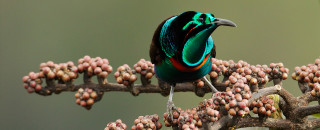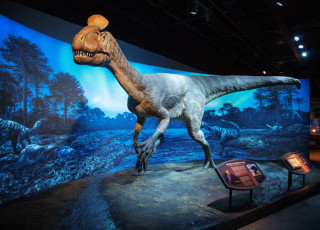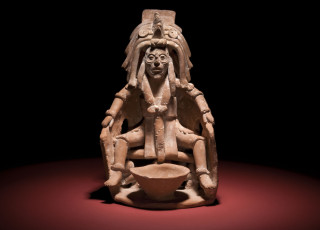Birds of Paradise: An Amazing Avian Evolution
The Natural History Museum of Utah would like to take you on an expedition into the dense jungles of New Guinea to meet some of the most exotic, colorful and unusual birds on the planet. No need to book a flight, just drop by the Museum to spend time in the new “Birds of Paradise: An Amazing Avian Evolution” exhibit running Saturday, Sept. 19 through Jan 3, 2015.
In the exhibit, created by National Geographic and The Cornell Lab of Ornithology, you’ll make your way through the New Guinea rainforest to witness the spectacular plumage, incredible dances and bizarre antics that male birds of paradise use to attract a mate. The birds’ stories have been captured by internationally acclaimed National Geographic photographer, Tim Laman, and Cornell Lab of Ornithology researcher, Edwin Scholes, and brought forth in the interactive, multi-media exhibit.
Laman and Scholes made 18 trips to New Guinea over eight years to complete the first-ever survey of all 39 known species of these elusive birds. Museum visitors will be dazzled by the exhibit’s stunning videos and photographs and will enjoy interacting with digital and mechanical exhibit stations that show how male and female birds of paradise select mates based on features they find attractive. Families will learn how specific physical traits are carried through subsequent generations, and even how new species are created through natural selection.
“The natural world is full of interesting curiosities and the Birds of Paradise Exhibit provides a look into many of them,” said Sarah George, executive director of the Museum. “These exotic birds of paradise use fancy dance moves on the ground, change their shapes, sing special mating calls and display incredibly beautiful feathered collars, crests and breast shields to attract a mate. It’s really fascinating.”
Birds of paradise continues to have a great influence on the New Guinea culture, and Museum visitors will see examples of the feathered headdresses, money and dances of the people. The Birds of Paradise Exhibit also offers a close up look a 100 year-old study of birds of paradise skins, and shows how the exotic birds influenced Victorian hat fashions, which led to a conservation movement.
The Natural History Museum of Utah will also feature a sister exhibit, Pigeons, highlighting local research that follows Charles Darwin’s footsteps in studying natural and artificial selection of pigeons. Research by Michael Shapiro, associate professor of biology at the University of Utah, the U of U’s Shapiro Lab and the Genetic Science Learning Center have identified specific genes that create pigeon feather colors, the formation of wings and legs and other features such as feather crests and behaviors such as tumbling. Shapiro and team have worked with local citizen scientists who are experts in breeding pigeons. This research in artificial selection has been applied to research on human variations such as skin color and albinism, clubfeet and other traits.
The pigeon exhibit will feature slow motion videos of roller and tumbler pigeons, photos of the astonishing varieties of pigeons and an actual 1867 pigeon specimen from India used in research by Charles Darwin himself. Children will have fun trying on pigeon costumes, beaks, eyes and wings to create their own “pigeon species.”
Special lectures and other activities related to the Birds of Paradise Exhibit will be featured at the Natural History Museum of Utah through January 3rd. For additional information, visit https://nhmu.utah.edu/ or call 801.581.4303.
Birds of Paradise and Pigeons are made possible through the generous support of (then list the sponsors on the back of our rack card, including ZAP)
# # #
About the Natural History Museum of Utah
The Natural History Museum of Utah is one of the leading scientific research and cultural institutions in the country. Established in 1963, the Museum‘s collections contain over 1.2 million objects and offers innovative exhibitions and educational programs to thousands of residents and visitors each year, including traveling and permanent exhibits, special events and other programs. With an expected attendance of 180,000 visitors a year, the Museum also offers a variety of outreach programs to communities and schools throughout Utah, reaching every school district in the state annually. The Museum has an active science program with more than 30 scientists and 10 field exhibitions each year.
ABOUT THE CORNELL LAB OF ORNITHOLOGY
The Cornell Lab of Ornithology is nonprofit, member-supported organization with the mission to interpret and conserve the earth’s biological diversity through research, education, and citizen science focused on birds. Founded in 1915, the Lab is supported by 50,000 members and engages 200,000 citizen-science participants and 6 million bird enthusiasts who connect online at www.allaboutbirds.org. As a proud unit of Cornell University, the Lab has a leading team of faculty, educators, conservation scientists, and engineers continuing a strong history of excellence in science, technological innovation, and outreach. Learn more at www.birds.cornell.edu.
ABOUT NATIONAL GEOGRAPHIC TRAVELING EXHIBITIONS
The National Geographic Society is one of the world’s largest nonprofit scientific and educational organizations and one of the world’s leading organizers of large-scale, traveling exhibitions. Since it launched “Tutankhamun and the Golden Age of the Pharaohs” in 2004, National Geographic has organized two more Egyptian-themed exhibitions, “Tutankhamun: The Golden King and the Great Pharaohs” and “Cleopatra: The Search for the Last Queen of Egypt.” Other exhibitions National Geographic has organized include the four-city U.S. tour of “Afghanistan: Hidden Treasures from the National Museum, Kabul.” National Geographic also offers a broad selection of stunning photography exhibitions to museums and venues around the world. For more information, visit www.nationalgeographic.com.
Press contacts and links
-
Press Contact
Beth Mitchell



